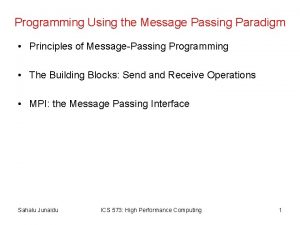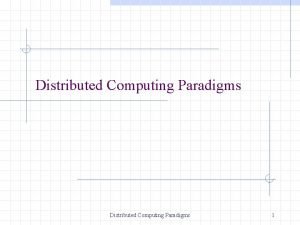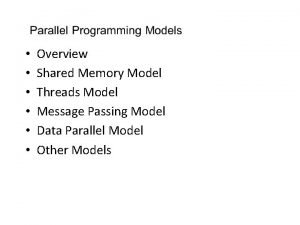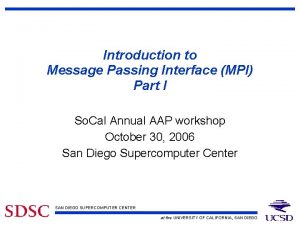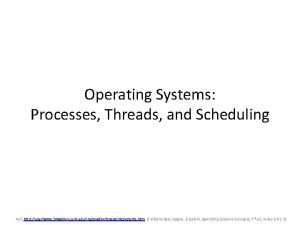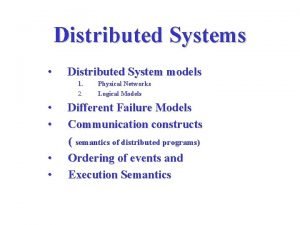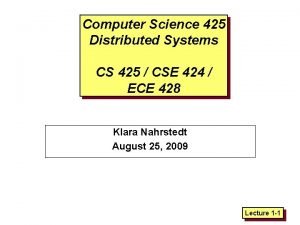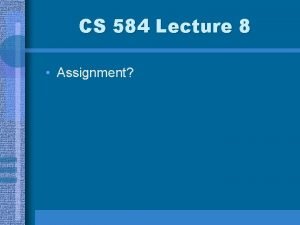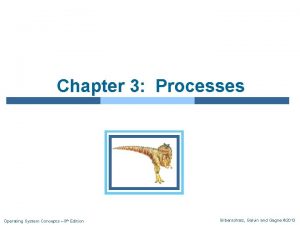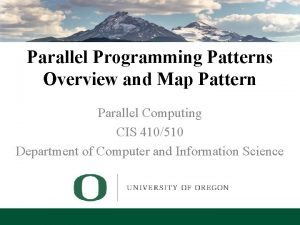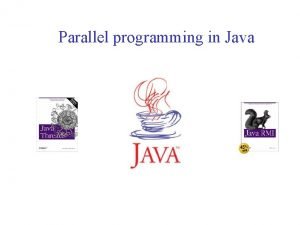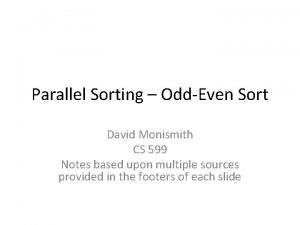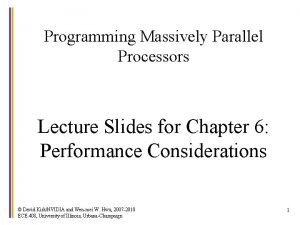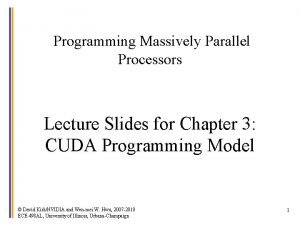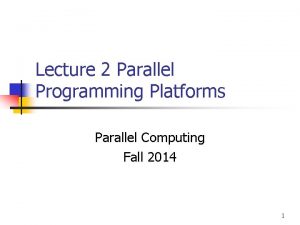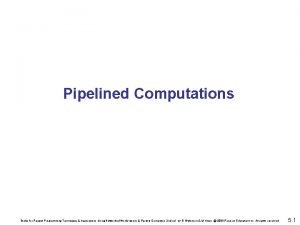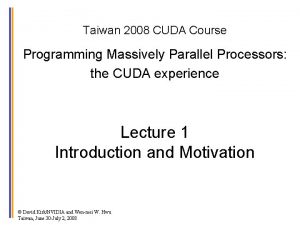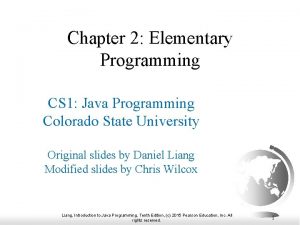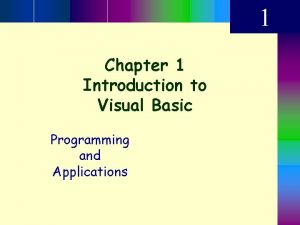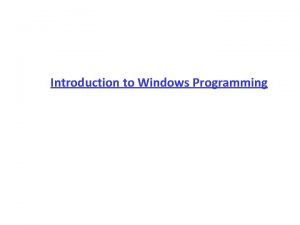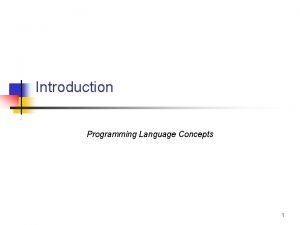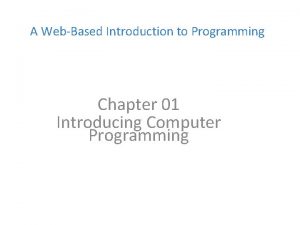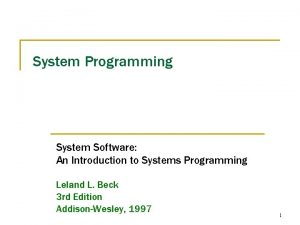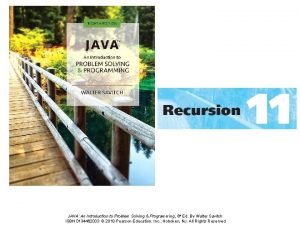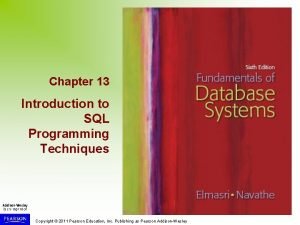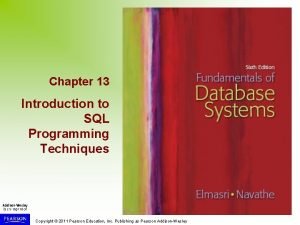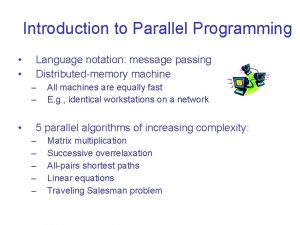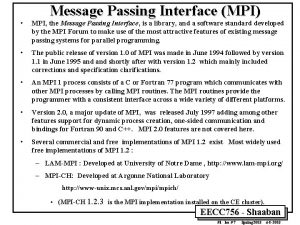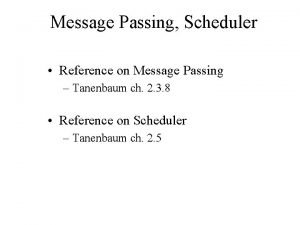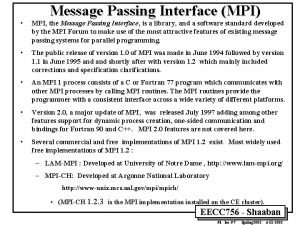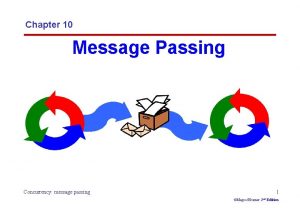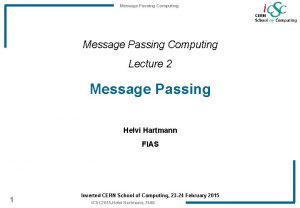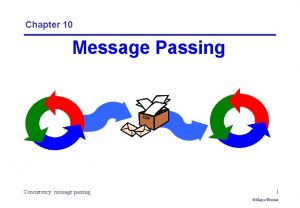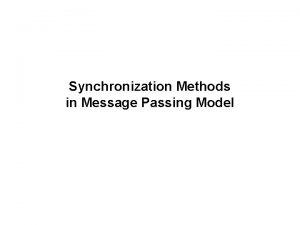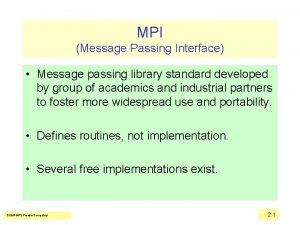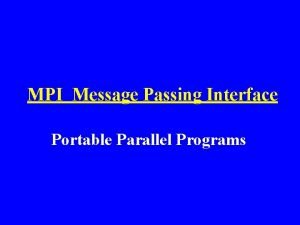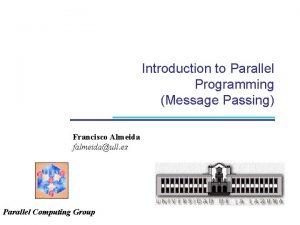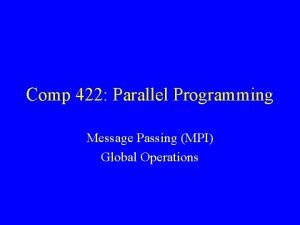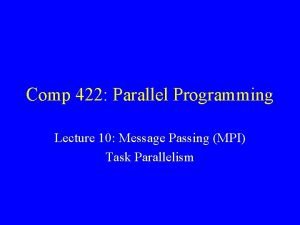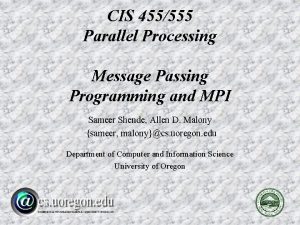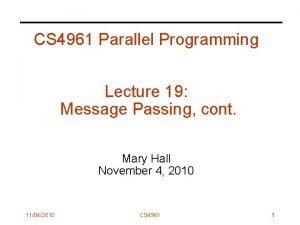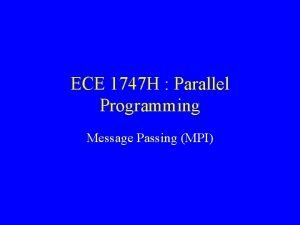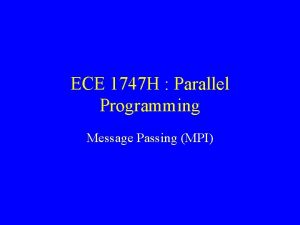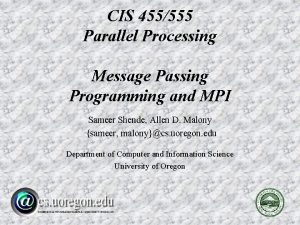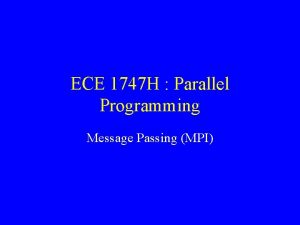Introduction to Parallel Programming Language notation message passing





![Parallel Algorithm 1 Slaves: Master (processor 0): int Aix[N], Bxj[N], Cij; for (i = Parallel Algorithm 1 Slaves: Master (processor 0): int Aix[N], Bxj[N], Cij; for (i =](https://slidetodoc.com/presentation_image/5c96662907c656e6be0813de973e8025/image-6.jpg)




![Parallel Algorithm 3 Master (processor 0): Slaves: int result [N, N/nprocs]; int A[N/nprocs, N], Parallel Algorithm 3 Master (processor 0): Slaves: int result [N, N/nprocs]; int A[N/nprocs, N],](https://slidetodoc.com/presentation_image/5c96662907c656e6be0813de973e8025/image-11.jpg)









![Parallel SOR float G[lb-1: ub+1, 1: M], Gnew[lb-1: ub+1, 1: M]; for (step = Parallel SOR float G[lb-1: ub+1, 1: M], Gnew[lb-1: ub+1, 1: M]; for (step =](https://slidetodoc.com/presentation_image/5c96662907c656e6be0813de973e8025/image-21.jpg)




![Parallel ASP Algorithm int lb, ub; int row. K[N], C[lb: ub, N]; /* lower/upper Parallel ASP Algorithm int lb, ub; int row. K[N], C[lb: ub, N]; /* lower/upper](https://slidetodoc.com/presentation_image/5c96662907c656e6be0813de973e8025/image-26.jpg)
![Parallel ASP Algorithm int lb, ub; int row. K[N], C[lb: ub, N]; /* lower/upper Parallel ASP Algorithm int lb, ub; int row. K[N], C[lb: ub, N]; /* lower/upper](https://slidetodoc.com/presentation_image/5c96662907c656e6be0813de973e8025/image-27.jpg)
![Parallel ASP Algorithm int lb, ub; int row. K[N], C[lb: ub, N]; /* lower/upper Parallel ASP Algorithm int lb, ub; int row. K[N], C[lb: ub, N]; /* lower/upper](https://slidetodoc.com/presentation_image/5c96662907c656e6be0813de973e8025/image-28.jpg)


![int lb, ub; int row. K[N], C[lb: ub, N]; Parallel ASP Algorithm for (k int lb, ub; int row. K[N], C[lb: ub, N]; Parallel ASP Algorithm for (k](https://slidetodoc.com/presentation_image/5c96662907c656e6be0813de973e8025/image-31.jpg)
















![A Search Problem Given an array A[1. . N] and an item x, check A Search Problem Given an array A[1. . N] and an item x, check](https://slidetodoc.com/presentation_image/5c96662907c656e6be0813de973e8025/image-48.jpg)
![Parallel Search on 2 CPUs int lb, ub; int A[lb: ub]; for (i = Parallel Search on 2 CPUs int lb, ub; int A[lb: ub]; for (i =](https://slidetodoc.com/presentation_image/5c96662907c656e6be0813de973e8025/image-49.jpg)




















- Slides: 69

Introduction to Parallel Programming • Language notation: message passing • 5 parallel algorithms of increasing complexity: 1. 2. 3. 4. 5. Matrix multiplication Successive overrelaxation All-pairs shortest paths Linear equations Search problem

Message Passing • SEND (destination, message) – blocking: wait until message has arrived – non blocking: continue immediately • RECEIVE (source, message) • RECEIVE-FROM-ANY (message) – blocking: wait until message is available – non blocking: test if message is available

Parallel Matrix Multiplication • Given two N x N matrices A and B • Compute C = A x B • Cij = Ai 1 B 1 j + Ai 2 B 2 j +. . + Ai. NBNj

Sequential Matrix Multiplication for (i = 1; i <= N; i++) for (j = 1; j <= N; j++) C [i, j] = 0; for (k = 1; k <= N; k++) C[i, j] += A[i, k] * B[k, j]; • The order of the operations is overspecied • Everything can be computed in parallel

Parallel Algorithm 1 Each processor computes 1 element of C Requires N 2 processors Need 1 row of A and 1 column of B as input
![Parallel Algorithm 1 Slaves Master processor 0 int AixN BxjN Cij for i Parallel Algorithm 1 Slaves: Master (processor 0): int Aix[N], Bxj[N], Cij; for (i =](https://slidetodoc.com/presentation_image/5c96662907c656e6be0813de973e8025/image-6.jpg)
Parallel Algorithm 1 Slaves: Master (processor 0): int Aix[N], Bxj[N], Cij; for (i = 1; i <= N; i++) RECEIVE(0, &Aix, &Bxj, &i, &j); for (j = 1; j <= N; j++) Cij = 0; SEND(p++, A[i, *], B[*, j], i, j); for (k = 1; k <= N; k++) Cij += Aix[k] * Bxj[k]; for (x = 1; x <= N*N; x++) SEND(0, Cij , i, j); RECEIVE_FROM_ANY(&result, &i, &j); C[i, j] = result;

Parallel Algorithm 2 Each processor computes 1 row (N elements) of C Requires N processors Need entire B matrix and 1 row of A as input

Parallel Algorithm 2 Master (processor 0): Slaves: for (i = 1; i <= N; i++) int Aix[N], B[N, N], C[N]; SEND (i, A[i, *], B[*, *], i); RECEIVE(0, &Aix, &B, &i); for (x = 1; x <= N; x++) for (j = 1; j <= N; j++) RECEIVE_FROM_ANY (&result, &i); C[j] = 0; C[i, *] = result[*]; for (k = 1; k <= N; k++) C[j] += Aix[k] * B[j, k]; SEND(0, C[*] , i);

Problem: need larger granularity So far, each parallel task needs as much communication as computation Assumption: N >> P (i. e. we solve a large problem) Assign many rows to each processor

Parallel Algorithm 3 Each processor computes N/P rows of C Need entire B matrix and N/P rows of A as input
![Parallel Algorithm 3 Master processor 0 Slaves int result N Nnprocs int ANnprocs N Parallel Algorithm 3 Master (processor 0): Slaves: int result [N, N/nprocs]; int A[N/nprocs, N],](https://slidetodoc.com/presentation_image/5c96662907c656e6be0813de973e8025/image-11.jpg)
Parallel Algorithm 3 Master (processor 0): Slaves: int result [N, N/nprocs]; int A[N/nprocs, N], B[N, N], C[N/nprocs, N]; int inc = N/nprocs; /* number of rows per cpu */ RECEIVE(0, &A, &B, &lb, &ub); int lb = 1; for (i = lb; i <= ub; i++) for (i = 1; i <= nprocs; i++) SEND (i, A[lb. . lb+inc-1, *], B[*, *], lb+inc-1); for (j = 1; j <= N; j++) lb += inc; C[i, j] = 0; for (x = 1; x <= nprocs; x++) for (k = 1; k <= N; k++) RECEIVE_FROM_ANY (&result, &lb); C[i, j] += A[i, k] * B[k, j]; for (i = 1; i <= N/nprocs; i++) SEND(0, C[*, *] , lb); C[lb+i-1, *] = result[i, *];

Comparison Algorith m Parallelism (#jobs) Communication per job Computation per job Ratio (comp/comm) 1 N 2 N+ N+1 N O(1) 2 N N + N 2 +N N 2 O(1) 3 P N 2/P + N 2/P N 3/P O(N/P) • If N >> P, algorithm 3 will have low communication overhead • Its grain size is high

Discussion • Matrix multiplication is trivial to parallelize • Getting good performance is a problem • Need right grain size • Need large input problem

Successive Over relaxation (SOR) Iterative method for solving Laplace equations Repeatedly updates elements of a grid float G[1: N, 1: M], Gnew[1: N, 1: M]; for (step = 0; step < NSTEPS; step++) for (i = 2; i < N; i++) /* update grid */ for (j = 2; j < M; j++) Gnew[i, j] = f(G[i, j], G[i-1, j], G[i+1, j], G[i, j-1], G[i, j+1]); G = Gnew;

SOR example

SOR example

Parallelizing SOR • Domain decomposition on the grid • Each processor owns N/P rows • Need communication between neighbors to exchange elements at processor boundaries

SOR example partitioning

SOR example partitioning

Communication scheme Each CPU communicates with left & right neighbor (if existing)
![Parallel SOR float Glb1 ub1 1 M Gnewlb1 ub1 1 M for step Parallel SOR float G[lb-1: ub+1, 1: M], Gnew[lb-1: ub+1, 1: M]; for (step =](https://slidetodoc.com/presentation_image/5c96662907c656e6be0813de973e8025/image-21.jpg)
Parallel SOR float G[lb-1: ub+1, 1: M], Gnew[lb-1: ub+1, 1: M]; for (step = 0; step < NSTEPS; step++) SEND(cpuid-1, G[lb]); /* send 1 st row left */ SEND(cpuid+1, G[ub]); /* send last row right */ RECEIVE(cpuid-1, G[lb-1]); /* receive from left */ RECEIVE(cpuid+1, G[ub+1]); /* receive from right */ for (i = lb; i <= ub; i++) /* update my rows */ for (j = 2; j < M; j++) Gnew[i, j] = f(G[i, j], G[i-1, j], G[i+1, j], G[i, j-1], G[i, j+1]); G = Gnew;

Performance of SOR Communication and computation during each iteration: • Each processor sends/receives 2 messages with M reals • Each processor computes N/P * M updates The algorithm will have good performance if • Problem size is large: N >> P • Message exchanges can be done in parallel

All-pairs Shorts Paths (ASP) • Given a graph G with a distance table C: C [ i , j ] = length of direct path from node i to node j • Compute length of shortest path between any two nodes in G

Floyd's Sequential Algorithm • Basic step: for (k = 1; k <= N; k++) for (i = 1; i <= N; i++) for (j = 1; j <= N; j++) C [ i , j ] = MIN ( C [i, j], C [i , k] +C [k, j]);

Parallelizing ASP • Distribute rows of C among the P processors • During iteration k, each processor executes C [i, j] = MIN (C[i , j], C[i, k] + C[k, j]); on its own rows i, so it needs these rows and row k • Before iteration k, the processor owning row k sends it to all the others
![Parallel ASP Algorithm int lb ub int row KN Clb ub N lowerupper Parallel ASP Algorithm int lb, ub; int row. K[N], C[lb: ub, N]; /* lower/upper](https://slidetodoc.com/presentation_image/5c96662907c656e6be0813de973e8025/image-26.jpg)
Parallel ASP Algorithm int lb, ub; int row. K[N], C[lb: ub, N]; /* lower/upper bound for this CPU */ /* pivot row ; matrix */ for (k = 1; k <= N; k++) if (k >= lb && k <= ub) /* do I have it? */ row. K = C[k, *]; for (p = 1; p <= nproc; p++) /* broadcast row */ if (p != myprocid) SEND(p, row. K); else RECEIVE_FROM_ANY(&row. K); /* receive row */ for (i = lb; i <= ub; i++) /* update my rows */ for (j = 1; j <= N; j++) C[i, j] = MIN(C[i, j], C[i, k] + row. K[j]);
![Parallel ASP Algorithm int lb ub int row KN Clb ub N lowerupper Parallel ASP Algorithm int lb, ub; int row. K[N], C[lb: ub, N]; /* lower/upper](https://slidetodoc.com/presentation_image/5c96662907c656e6be0813de973e8025/image-27.jpg)
Parallel ASP Algorithm int lb, ub; int row. K[N], C[lb: ub, N]; /* lower/upper bound for this CPU */ /* pivot row ; matrix */ for (k = 1; k <= N; k++) for (i = lb; i <= ub; i++) /* update my rows */ for (j = 1; j <= N; j++) C[i, j] = MIN(C[i, j], C[i, k] + row. K[j]);
![Parallel ASP Algorithm int lb ub int row KN Clb ub N lowerupper Parallel ASP Algorithm int lb, ub; int row. K[N], C[lb: ub, N]; /* lower/upper](https://slidetodoc.com/presentation_image/5c96662907c656e6be0813de973e8025/image-28.jpg)
Parallel ASP Algorithm int lb, ub; int row. K[N], C[lb: ub, N]; /* lower/upper bound for this CPU */ /* pivot row ; matrix */ for (k = 1; k <= N; k++) if (k >= lb && k <= ub) /* do I have it? */ row. K = C[k, *]; for (p = 1; p <= nproc; p++) /* broadcast row */ if (p != myprocid) SEND(p, row. K); else RECEIVE_FROM_ANY(&row. K); /* receive row */ for (i = lb; i <= ub; i++) /* update my rows */ for (j = 1; j <= N; j++) C[i, j] = MIN(C[i, j], C[i, k] + row. K[j]);

Performance Analysis ASP Per iteration: • 1 CPU sends P -1 messages with N integers • Each CPU does N/P x N comparisons Communication/ computation ratio is small if N >> P

. . . but, is the Algorithm Correct?
![int lb ub int row KN Clb ub N Parallel ASP Algorithm for k int lb, ub; int row. K[N], C[lb: ub, N]; Parallel ASP Algorithm for (k](https://slidetodoc.com/presentation_image/5c96662907c656e6be0813de973e8025/image-31.jpg)
int lb, ub; int row. K[N], C[lb: ub, N]; Parallel ASP Algorithm for (k = 1; k <= N; k++) if (k >= lb && k <= ub) row. K = C[k, *]; for (p = 1; p <= nproc; p++) if (p != myprocid) SEND(p, row. K); else RECEIVE_FROM_ANY (&row. K); for (i = lb; i <= ub; i++) for (j = 1; j <= N; j++) C[i, j] = MIN(C[i, j], C[i, k] + row. K[j]);

Non-FIFO Message Ordering Row 2 may be received before row 1

FIFO Ordering Row 5 may be received before row 4

Correctness Problems: • Asynchronous non-FIFO SEND • Messages from different senders may overtake each other

Correctness Problems: • Asynchronous non-FIFO SEND • Messages from different senders may overtake each other Solutions:

Correctness Problems: • Asynchronous non-FIFO SEND • Messages from different senders may overtake each other Solutions: • Synchronous SEND (less efficient)

Correctness Problems: • Asynchronous non-FIFO SEND • Messages from different senders may overtake each other Solutions: • Synchronous SEND (less efficient) • Barrier at the end of outer loop (extra communication)

Correctness Problems: • Asynchronous non-FIFO SEND • Messages from different senders may overtake each other Solutions: • Synchronous SEND (less efficient) • Barrier at the end of outer loop (extra communication) • Order incoming messages (requires buffering)

Correctness Problems: • Asynchronous non-FIFO SEND • Messages from different senders may overtake each other Solutions: • Synchronous SEND (less efficient) • Barrier at the end of outer loop (extra communication) • Order incoming messages (requires buffering) • RECEIVE (cpu, msg) (more complicated)

Linear equations • Linear equations: a 1, 1 x 1 + a 1, 2 x 2 + …a 1, nxn = b 1. . . an, 1 x 1 + an, 2 x 2 + …an, nxn = bn • Matrix notation: Ax = b • Problem: compute x, given A and b • Linear equations have many important applications Practical applications need huge sets of equations

Solving a linear equation • Two phases: Upper-triangularization -> Ux = y Back-substitution -> x • Most computation time is in upper-triangularization • Upper-triangular matrix: U [i, i] = 1 U [i, j] = 0 if i > j

Sequential Gaussian elimination for (k = 1; k <= N; k++) for (j = k+1; j <= N; j++) A[k, j] = A[k, j] / A[k, k] y[k] = b[k] / A[k, k] = 1 for (i = k+1; i <= N; i++) for (j = k+1; j <= N; j++) A[i, j] = A[i, j] - A[i, k] * A[k, j] b[i] = b[i] - A[i, k] * y[k] A[i, k] = 0 • Converts Ax = b into Ux = y • Sequential algorithm uses 2/3 N 3 operations

Parallelizing Gaussian elimination • Row-wise partitioning scheme Each cpu gets one row (striping ) Execute one (outer-loop) iteration at a time • Communication requirement: During iteration k, cpus Pk+1 … Pn-1 need part of row k This row is stored on CPU Pk -> need partial broadcast (multicast)

Communication

Performance problems • Communication overhead (multicast) • Load imbalance CPUs P 0…PK are idle during iteration k • In general, number of CPUs is less than n Choice between block-striped and cyclic-striped distribution • Block-striped distribution has high load-imbalance • Cyclic-striped distribution has less load-imbalance

Block-striped distribution

Cyclic-striped distribution
![A Search Problem Given an array A1 N and an item x check A Search Problem Given an array A[1. . N] and an item x, check](https://slidetodoc.com/presentation_image/5c96662907c656e6be0813de973e8025/image-48.jpg)
A Search Problem Given an array A[1. . N] and an item x, check if x is present in A int present = false; for (i = 1; !present && i <= N; i++) if ( A [i] == x) present = true;
![Parallel Search on 2 CPUs int lb ub int Alb ub for i Parallel Search on 2 CPUs int lb, ub; int A[lb: ub]; for (i =](https://slidetodoc.com/presentation_image/5c96662907c656e6be0813de973e8025/image-49.jpg)
Parallel Search on 2 CPUs int lb, ub; int A[lb: ub]; for (i = lb; i <= ub; i++) if (A [i] == x) print(“ Found item"); SEND(1 -cpuid); /* send other CPU empty message*/ exit(); /* check message from other CPU: */ if (NONBLOCKING_RECEIVE(1 -cpuid)) exit()

Performance Analysis How much faster is the parallel program than the sequential program for N=100 ?

Performance Analysis How much faster is the parallel program than the sequential program for N=100 ? 1. if x not present => factor 2

Performance Analysis How much faster is the parallel program than the sequential program for N=100 ? 1. if x not present => factor 2 2. if x present in A[1. . 50] => factor 1

Performance Analysis How much faster is the parallel program than the sequential program for N=100 ? 1. if x not present => factor 2 2. if x present in A[1. . 50] => factor 1 3. if A[51] = x => factor 51

Performance Analysis How much faster is the parallel program than the sequential program for N=100 ? 1. if x not present => factor 2 2. if x present in A[1. . 50] => factor 1 3. if A[51] = x => factor 51 4. if A[75] = x => factor 3

Performance Analysis How much faster is the parallel program than the sequential program for N=100 ? 1. if x not present => factor 2 2. if x present in A[1. . 50] => factor 1 3. if A[51] = x => factor 51 4. if A[75] = x => factor 3 In case 2 the parallel program does more work than the sequential program => search overhead

Performance Analysis How much faster is the parallel program than the sequential program for N=100 ? 1. if x not present => factor 2 2. if x present in A[1. . 50] => factor 1 3. if A[51] = x => factor 51 4. if A[75] = x => factor 3 In case 2 the parallel program does more work than the sequential program => search overhead In cases 3 and 4 the parallel program does less work => negative search overhead

Discussion Several kinds of performance overhead

Discussion Several kinds of performance overhead • Communication overhead

Discussion Several kinds of performance overhead • Communication overhead • Load imbalance

Discussion Several kinds of performance overhead • Communication overhead • Load imbalance • Search overhead

Discussion Several kinds of performance overhead • Communication overhead • Load imbalance • Search overhead Making algorithms correct is nontrivial

Discussion Several kinds of performance overhead • Communication overhead • Load imbalance • Search overhead Making algorithms correct is nontrivial • Message ordering

Designing Parallel Algorithms Source: Designing and building parallel programs (Ian Foster, 1995) • Partitioning • Communication • Agglomeration • Mapping

Figure 2. 1 from Foster's book

Partitioning • Domain decomposition Partition the data Partition computations on data (owner-computes rule) • Functional decomposition Divide computations into subtasks E. g. search algorithms

Communication • Analyze data-dependencies between partitions • Use communication to transfer data • Many forms of communication, e. g. Local communication with neighbors (SOR) Global communication with all processors (ASP) Synchronous (blocking) communication Asynchronous (non blocking) communication

Agglomeration • Reduce communication overhead by – increasing granularity – improving locality

Mapping • On which processor to execute each subtask? • Put concurrent tasks on different CPUs • Put frequently communicating tasks on same CPU? • Avoid load imbalances

Summary Hardware and software models Example applications • Matrix multiplication - Trivial parallelism (independent tasks) • Successive over relaxation - Neighbor communication • All-pairs shortest paths - Broadcast communication • Linear equations - Load balancing problem • Search problem - Search overhead Designing parallel algorithms
 Principles of message passing programming
Principles of message passing programming Features of message passing system
Features of message passing system Divergence of darkness
Divergence of darkness Distributed computing paradigms
Distributed computing paradigms Message passing
Message passing Desirable features of good message passing system
Desirable features of good message passing system Message passing model
Message passing model Variational message passing
Variational message passing Message passing interface tutorial
Message passing interface tutorial Quick passing game
Quick passing game Message passing system in distributed system
Message passing system in distributed system Distributed system models
Distributed system models Message passing system in distributed system
Message passing system in distributed system Erlang message passing
Erlang message passing Interprocess communication shared memory
Interprocess communication shared memory Message passing interface
Message passing interface Message passing os
Message passing os An introduction to parallel programming peter pacheco
An introduction to parallel programming peter pacheco What is hardware description language
What is hardware description language Mega engineering notation
Mega engineering notation Infix equation
Infix equation Rpn expression
Rpn expression Reverse polish notation
Reverse polish notation Perbedaan linear programming dan integer programming
Perbedaan linear programming dan integer programming Greedy vs dynamic programming
Greedy vs dynamic programming Runtime programming
Runtime programming Integer programming vs linear programming
Integer programming vs linear programming Programing adalah
Programing adalah Programming massively parallel processors
Programming massively parallel processors Parallel programming patterns
Parallel programming patterns Parallel programming java
Parallel programming java Bubble sort mpi
Bubble sort mpi Mpi parallel programming in c
Mpi parallel programming in c Programming massively parallel processors
Programming massively parallel processors Programming massively parallel processors
Programming massively parallel processors Parallel programming platforms
Parallel programming platforms F# parallel programming
F# parallel programming Parallel programming
Parallel programming Programming massively parallel processors, kirk et al.
Programming massively parallel processors, kirk et al. Parallel forces
Parallel forces What are the two focal points of a fingerprint
What are the two focal points of a fingerprint Annie's dress was old, faded, and it had wrinkles.
Annie's dress was old, faded, and it had wrinkles. Parallel and non parallel structure
Parallel and non parallel structure Parallel structure means using the same pattern of
Parallel structure means using the same pattern of Parallel input parallel output
Parallel input parallel output What is parallelism and examples
What is parallelism and examples Introduction to server side programming
Introduction to server side programming Java introduction to problem solving and programming
Java introduction to problem solving and programming Introduction to programming languages
Introduction to programming languages Daniel liang introduction to java programming
Daniel liang introduction to java programming Introduction to visual basic
Introduction to visual basic What does plc stand for?
What does plc stand for? Programming and problem solving with java
Programming and problem solving with java Introduction to windows programming
Introduction to windows programming Introduction to programming
Introduction to programming Csc102
Csc102 A web based introduction to programming
A web based introduction to programming Sic programming examples
Sic programming examples Computer programming chapter 1
Computer programming chapter 1 C programming lectures
C programming lectures Introduction to visual basic
Introduction to visual basic Introduction to programming concepts with scratch
Introduction to programming concepts with scratch Python programming an introduction to computer science
Python programming an introduction to computer science Java introduction to problem solving and programming
Java introduction to problem solving and programming History of python
History of python Introduction to java programming 10th edition quizzes
Introduction to java programming 10th edition quizzes Introduction to sql programming techniques
Introduction to sql programming techniques Introduction to sql programming techniques
Introduction to sql programming techniques Chapter 1 introduction to computers and programming
Chapter 1 introduction to computers and programming C programming chapter 1
C programming chapter 1
